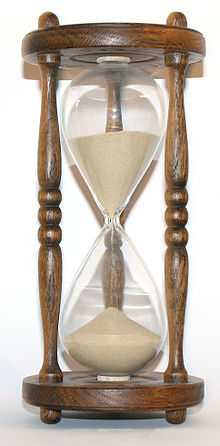Kāla (time)
Kālá (Sanskrit: काल, IPA: [kɑːˈlə]) is a Sanskrit word which means "Time".[1] It is also the name of a deity in which sense it is not always distinguishable from kāla meaning "black". It often used as one of the various names or forms of Yama.
Etymology
Monier-Williams's widely used Sanskrit-English dictionary[2] lists two distinct words with the form kāla.
- kāla 1 means "black, of a dark colour, dark-blue ..." and has a feminine form ending in ī – kālī – as mentioned in Pāṇini 4-1, 42.
- kāla 2 means "a fixed or right point of time, a space of time, time ... destiny, fate ... death" and has a feminine form (found at the end of compounds) ending in ā, as mentioned in the ṛgveda Prātiśākhya. As a traditional Hindu unit of time, one kālá corresponds to 144 seconds.
According to Monier-Williams, kāla 2 is from the verbal root kal "to calculate", while the root of kāla 1 is uncertain, though possibly the same.
Kāla as a deity
As applied to gods and goddesses in works such as the Devī Māhātmya and the Skanda Purāṇa, kāla 1 and kāla 2 are not readily distinguishable. Thus Wendy Doniger, translating a conversation between Śiva and Pārvatī from the Skanda Purāṇa, says Mahākāla may mean " 'the Great Death' ... or 'the Great Black One' ".[3] And Swāmī Jagadīśvarānanda, a Hindu translator of the Devī Māhātmya, renders the feminine compound kāla-rātri (where rātri means "night") as "dark night of periodic dissolution".[4]
As Time personified, destroying all things, Kala is a god of death sometimes identified with Yama.
Kāla in other cultures
In Javanese mythology, Batara Kala is the god of destruction. Batara Kala is depicted as giant, born of the sperm of Bathara Guru, the kings of gods.
In Borobudur, the gate to the stairs is adorned with a giant head, making the gate look like the open mouth of the giant. Many other gates in Javanese traditional buildings have this kind of ornament. Perhaps the most detailed Kala Face in Java is on the south side of Candi Kalasan.
See also
- Kalachakra
- Kālī
- Mahakala
References
- ↑ Roshen Dalal (5 October 2011). Hinduism: An Alphabetical Guide. Penguin Books India. pp. 185–. ISBN 978-0-14-341421-6. Retrieved 19 December 2012.
- ↑ Sanskrit, Tamil and Pahlavi Dictionaries
- ↑ Doniger O'Flaherty, Wendy; Hindu Myths; Penguin, 1975; ISBN 0-14-044306-1 footnote to page 253.
- ↑ Jagadīśvarānanda trans; Devi Mahatmyam (Sanskrit and English); Sri Ramakrishna Math, Madras, 1953; chapter 1 verse 78.
| |||||||||||||||||||||
| |||||||||||||||||||||||||||||||||||||||||||||||||||||||||||||||||

